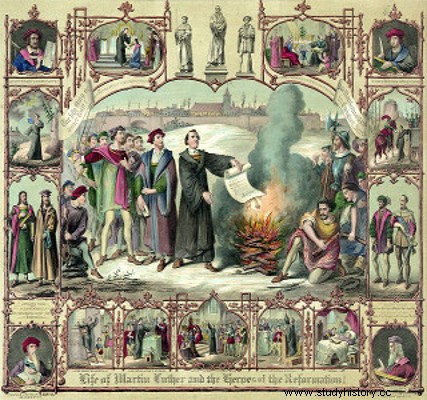
By Tales Pinto
Martin Luther was the main name associated with the Protestant Reformation of the sixteenth century. However, considerable parts of his reforming ideas came from the inspiration of other men who had criticized the Catholic Church decades before the German priest.
In England, at the end of the 14th century, the priest and theologian John Wyclif presented a series of criticisms of Catholic doctrines that would inspire Martin Luther more than a century later. Among them were the assertion that eternal salvation was achieved through faith in God, as well as the position against the sale of indulgences - the forgiveness granted by the church to sinners - practiced by the Catholic clergy.
Following these positions, Wyclif would also oppose the Catholic doctrine that the performance of “good works” (such as donations to the church) would also be a way to achieve eternal salvation. . These positions directly influenced Martin Luther in the elaboration of his 95 Theses posted in the Cathedral of Wittenberg.
Jan Hus it was also another important source of inspiration for Luther. Hus defended, like Wyclif before him and Luther later, the authority of Holy Scripture, like the Bible, over the tradition of the Catholic Church and over the word of the pope, which was held to be the word of God. This position affronted the religious power of the pope and opened the way for all the faithful to read and interpret the Bible. The consequences on the earthly plane were the expansion of literacy to a greater number of people, since previously only priests read the Bible and orally expressed their interpretation of the sacred texts to the faithful.
Another point common to the three was their criticism of the wealth and luxury displayed by the Catholic Church. For the three Christian reformers, the Church should follow what would have been one of the first teachings of Christ, maintaining a poor Church, more concerned with the business of faith than with material accumulation.
The positions of the three reformers also served to frame important peasant social conflicts between the 14th and 16th centuries. Religious issues in the period began to take the form of practical criticism, on the part of the peasantry, of the economic, political and military power held by the aristocracy. The difference in this case is that Martin Luther stood against the rebellions, condemning peasant actions, while John Wyclif and Jan Hus supported and/or influenced them.
Finally, it is interesting to note that in this historical period, between the end of the Middle Ages and the beginning of the Modern Age, religious divergences took on the character of social conflict due to the fact that religious power constitutes the basis of economic power.
As the Catholic Church is the largest landowner in Europe, as well as the social position of the aristocracy being based on a supposed divine will, the struggles of peasants and other popular classes against exploitation they ended up reaching the religious concepts that ideologically justified this entire social situation. All these conflicts would mark the decline of Catholic power and the beginning of a distinct historical period, marked by the strength of capitalists.
* Image Credit:US Library of Congress
